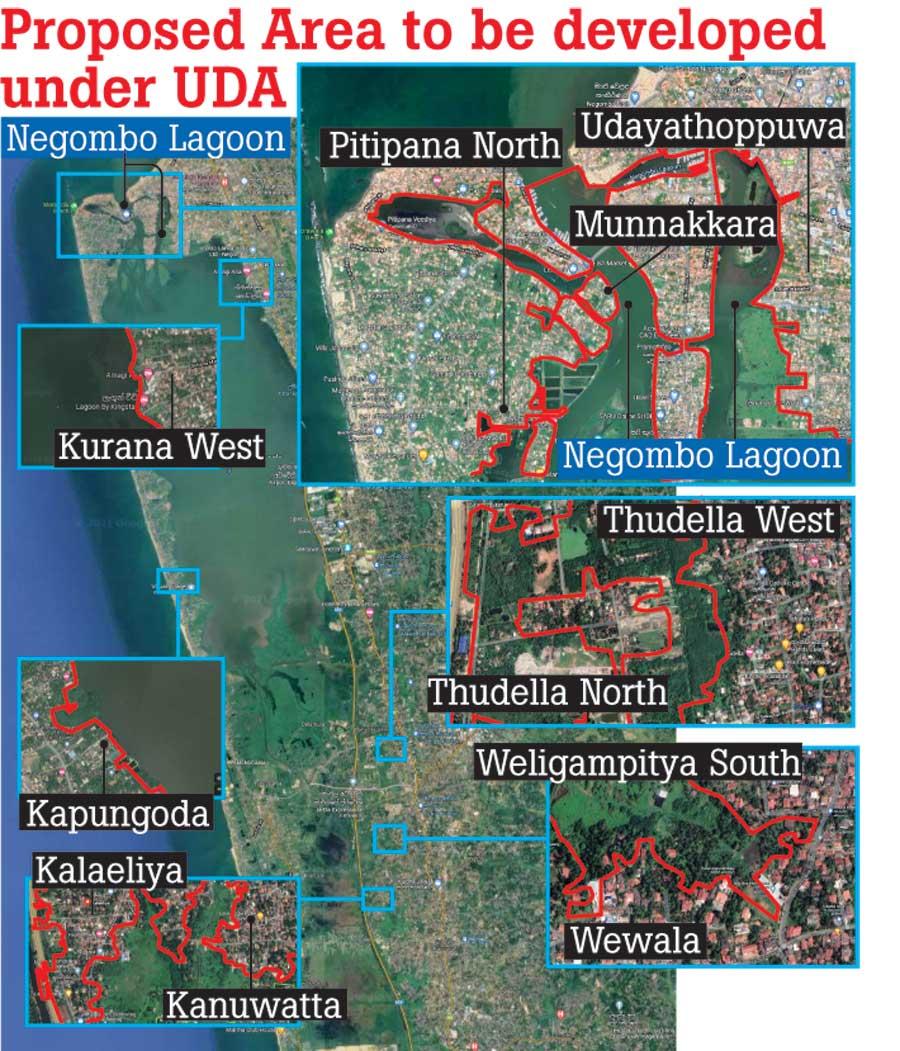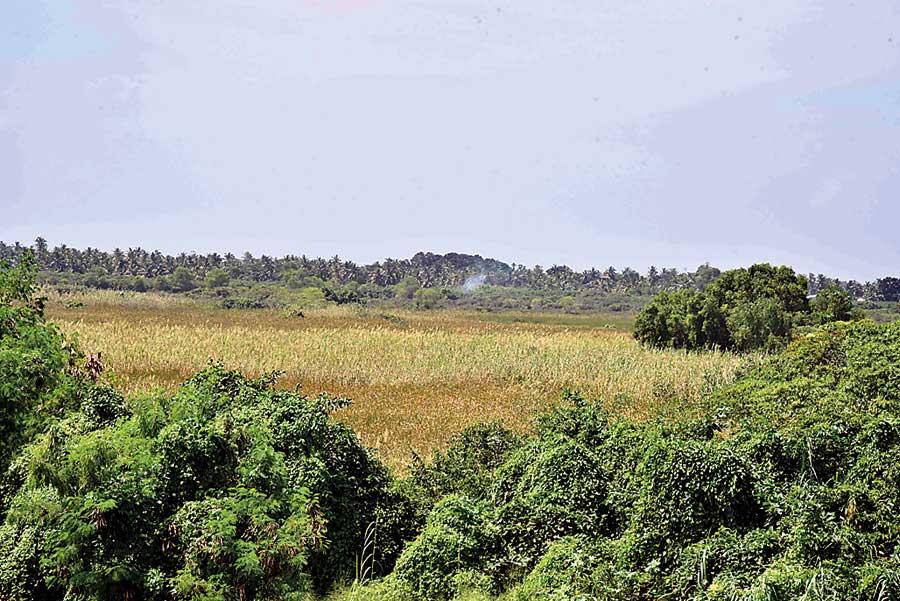Reply To:
Name - Reply Comment
Last Updated : 2024-04-19 14:00:00
 Nilsirigama flooded due to prevailing rains
Nilsirigama flooded due to prevailing rains
Pics by Kithsiri De Mel
- As such, the Muthurajawela Wetland is exposed to the risk of rapid urbanization which would pose short-term and long-term impacts on Colombo and the suburbs
- Residents fear that this environmentally sensitive area would be given away for developmental projects
- The environmentally sensitive area in Muthurajawela, which has been protected as a sanctuary, has become a haven for illegal activities
- The purpose of the new gazette is to conserve environmentally sensitive areas in Muthurajawela and develop it as a Ramsar Wetland
Spanning over 3068 hectares, the Muthurajawela Wetland is considered a biodiversity hotspot. Even though the area has been gazetted as a sanctuary, its legal protection hasn’t been an obstacle to those with political affiliations who carry out illegal activities within the area. As such, the Muthurajawela Wetland is exposed to the risk of rapid urbanization which would pose short-term and long-term impacts on Colombo and the suburbs. The area which currently comes under the purview of the Central Environmental Authority and the Ministries of Environment and Wildlife Conservation was recently gazetted under the Urban Development Authority, as a means of conservation. But this move has raised doubts among environmentalists and area residents fear that this environmentally sensitive area would be given away for developmental projects. Following the gazette notification Colombo Archbishop Cardinal Malcolm Ranjith filed a writ petition at the Supreme Court requesting the President to revoke the gazette and allow relevant subject ministries and authorities to conserve the area. Even in this backdrop, concerns have been raised as to whether Muthurajawela could still be rescued from the grip of those carrying out illegal activities.
though the area has been gazetted as a sanctuary, its legal protection hasn’t been an obstacle to those with political affiliations who carry out illegal activities within the area. As such, the Muthurajawela Wetland is exposed to the risk of rapid urbanization which would pose short-term and long-term impacts on Colombo and the suburbs. The area which currently comes under the purview of the Central Environmental Authority and the Ministries of Environment and Wildlife Conservation was recently gazetted under the Urban Development Authority, as a means of conservation. But this move has raised doubts among environmentalists and area residents fear that this environmentally sensitive area would be given away for developmental projects. Following the gazette notification Colombo Archbishop Cardinal Malcolm Ranjith filed a writ petition at the Supreme Court requesting the President to revoke the gazette and allow relevant subject ministries and authorities to conserve the area. Even in this backdrop, concerns have been raised as to whether Muthurajawela could still be rescued from the grip of those carrying out illegal activities.

Waste dumping sites in Muthurajawela
"The Muthurajawela Sanctuary, which was previously a barren land, lies at a lower elevation when compared to the surrounding areas. Therefore it has the ability to collect water and retain it. This is why it is important to control floods that occur in Colombo - Dinusha Nanayakkara, an area resident"
"There’s a request to take these areas out. As per the directions given by President Rajapaksa we will amend the gazette accordingly. We will not be evacuating any people - UDA Director General Prasad Ranaweera"
"They say it’s for conservation purposes, but if they give away lands for commercial purposes then there is an issue. On the other hand two or three people aren’t sufficient to protect protected areas. The Central Environment Authority (CEA), Wildlife and Environment ministries need more people and technology to patrol these areas - Senior Environmental lawyer Dr. Jagath Gunawardena"

"Therefore, wetlands are important for the survival of these species. Wetlands are also highly dynamic systems that can undergo rapid change and therefore maintaining the ecological balance in wetlands is important to maintain them in an optimal state - Devaka Weerakoon, Professor in Zoology, Department of Zoology, University of Colombo"
Why the Muthurajawela Wetland needs to be preserved
“Any area that is permanently or temporarily covered with water can be defined as a wetland,” explained Devaka Weerakoon, Professor in Zoology, Department of Zoology, University of Colombo. “Therefore, wetlands include a wide range of ecosystems varying from flowing systems (streams and rivers) to standing systems (lakes, marshes. Ponds etc.,). They can be natural or manmade (Paddy lands, manmade reservoirs etc.,) ecosystems. Wetlands can also be classified based on the salinity of the water into freshwater (0-5 parts per thousand), brackish water (5-30 ppt), Salt water (30-50 ppt) and brine water (50+ ppt). Wetlands are amongst the most productive ecosystems in the world and therefore support complex food chains providing habitats to a wide range of organisms that live permanently in water (fish, shrimps) or spend part of their life cycle in water (frogs and many insects) live in close association with water (crocodiles, mammals such as fishing cats, otters, large number of bird species that use wetlands for feeding, breeding and resting). Therefore, wetlands play a critical role in maintaining global biodiversity.”
“Sri Lanka being an island has all four types of wetlands - freshwater (rivers, streams, marshes, reservoirs, paddy fields), brackish water (lagoons, estuaries, mangroves, salt marshes), Salt water (Coral reefs, sea grass beds) and brine water (salterns). These wetlands support a wide range of species varying from aquatic insects, freshwater fish, reptiles, birds, mammals and wetland plants). This assemblage includes large number of species that are found only in Sri Lanka (endemic to Sri Lanka) and many species that are threatened with extinction. Therefore, wetlands are important for the survival of these species. Wetlands are also highly dynamic systems that can undergo rapid change and therefore maintaining the ecological balance in wetlands is important to maintain them in an optimal state,” he continued.
When asked about the economic benefits that could be reaped from preserving Muthurajawela Wetland Prof. Weerakoon explained that wetlands provide a range of services to man such as food, flowers, medicine, timber, protection from both land-borne hazards (floods) or sea-borne hazards (Hurricanes, storm surges, tsunamis), recreational opportunities, spiritual upliftment, purification of water, purification of air, removal of pollutants in water etc., “Therefore, many human livelihoods and human well-being depends on wetlands. The ability of a wetland to provide these services depends on wetland health (i.e. maintaining the wetland at optimum state). This is the reason why wetlands should be preserved, managed, restored or conserved because human beings as well as many other organisms depend on them for their existence. Yet we have treated our wetlands poorly and have directly or indirectly contributed to their degradation (through release of wastewater containing pollutants, dumping solid waste, introduction of invasive species), loss (reclamation of wetlands) and fragmentation (unplanned development), resulting in the loss of these valuable services. Muthurajawela, being a coastal wetland, provides one of the most important services in the form of retaining flood water; especially during heavy rain. The climate change driven alteration of weather patterns has paved the way for large volumes of rain to occur over a short period leading to floods, storm surges, hurricanes etc. This has made coastal wetlands such as Muthurajawela even more important as they are our first line of defence against such hazards.
“Further, the upstream areas of Muthurajawela from Peliyagoda to Ja-ela are undergoing rapid urbanization which makes this area more vulnerable to floods (floods are a phenomenon defined based on impact on social-economic activities of human and therefore, urbanization places more people at risk unless it is planned properly). Thus in the phase of these two factors (rapid urbanization and climate change driven alteration of rainfall), it is vital to preserve and restore coastal wetlands to make our cities more resilient to natural hazards. In addition to this Muthurajawela wetlands provide other economic benefits such as recreation, food that can be derived from the wetlands (e.g. fish and shell fish) as shown by many studies over the years,” said Prof. Weerakoon.
Speaking further he said that the short-term impacts of filling wetlands include loss of species and loss of services that are being described above. “Long-term impacts include rapid reduction of resilience of urban population that lives adjacent to the wetlands as well as opportunity losses in terms of inability to accrue the potential economic benefits that wetlands offer.
“Filling of wetlands is a poor strategy that reflects on the inability of making plans by thinking creatively. Planners that do not have the sense to understand the long-term implications of wetland filling views wetland reclamation is the easy way out, but fail to realise that this type of development is unsustainable in the long run. There are many other options for meeting the development needs of a country. But this requires wise planners who have a vision and are aware of the global challenges that we are facing and try to find sustainable solutions that will benefit both nature and mankind. Unfortunately, Sri Lankan leaders and planners so far have not demonstrated this types of wisdom except in their elaborate election manifestos of plans which are destined for the proverbial shelf where they gather nothing but dust,” added Prof. Weerakoon.
"The gazette will be amended according to the capacity of the UDA. Therefore the UDA will study the problematic areas from Monday (November 15) and submit the amendments within a week - Mahinda Amaraweera Environment Minister"
Minister says ‘No’ to illegal projects
Following a discussion last week the UDA is now in the process of amending the gazette issued in October. “The gazette will be amended according to the capacity of the UDA,” opined Environment Minister Mahinda Amaraweera. “Therefore the UDA will study the problematic areas from Monday (November 15) and submit the amendments within a week,” the Minister said.
Amaraweera further said that none of the residents in surrounding areas will be evacuated. When asked why the Environment Ministry cannot handle the task of developing the Muthurajawela sanctuary as a Ramsar Wetland the Minister said that the UDA Act has more power and finances to carry out this task. “If it comes under the Wildlife Department or Ministry it would be difficult to make any changes,” the Minister said.
When asked about illegal projects taking place in the area the Minister said that no illegal project would be allowed within the sanctuary.
In a recent statement, State Minister for Urban Development, Coast Conservation and Waste Dr. Nalaka Godahewa reiterated the fact that no approval will be given to fill the Muthurajawela Wetland.
Plight of the Thalangama Wetland
Residents living near the historic Thalangama Wetland have raised concerns over the new Kelani-Athurugiriya highway expansion proposed to be built over the Thalangama Wetland Protection Area. In order to ensure a smoother process, the Wetland Protection Area was regazetted to accommodate the construction of a highway.
But, when contacted, Ministry of Highways Secretary R. Premasiri said that even though the area has been earmarked the project hasn’t commenced yet.
Responding to a query on threats to the Ramsar status in the area, Central Environmental Authority Chairman Siripala Amarasinghe said that there has been no progress with regards to the project and that an Environmental Impact Assessment (EIA) hasn’t been done as yet.
On the contrary, Environment Minister Amaraweera said that approval will be given to the project after going through the EIA and that an EIA is currently being done. “The final approval will be given only after the checking the EIA. There won’t be an issue with regards to the Ramsar status because we will consider the EIA first.” the
Minister said.

An illegal moonshine operation happening in broad daylight

Add comment
Comments will be edited (grammar, spelling and slang) and authorized at the discretion of Daily Mirror online. The website also has the right not to publish selected comments.
Reply To:
Name - Reply Comment
On March 26, a couple arriving from Thailand was arrested with 88 live animal
According to villagers from Naula-Moragolla out of 105 families 80 can afford
Is the situation in Sri Lanka so grim that locals harbour hope that they coul
A recent post on social media revealed that three purple-faced langurs near t